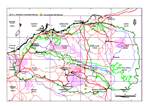Click on images
to enlarge



Photographer: B.R. Maslin

Photographer: E. Thoma
, BRM 4681, ORIGINAL SCAN, ADJUSTED RICHARD WOODMAN_sml.jpg)
Photographer: B.R. Maslin

Photographer: B.R. Maslin

Photographer: B.R. Maslin
, LSWE 7034, lab photo by Fiona McCallum ADJUSTED_sml.jpg)
Seed from one herbarium voucher. Scale in mm. Photographer: F. McCallum.
Botanical name
Acacia effusa Maslin, Nutysia 4: 85, figs 6 & 11 (1982)
Common name
Punurunha Minni Ritchi (prefered common name), Mt Bruce Minni Ritchi and Dwarf Minni Ritchi
Description
Low, dense, wide-spreading (0.6-3 m across), domed or flat-topped, somewhat viscid shrubs 0.3-1.2 m tall, with numerous slender stems arising from a basal woody stock. Bark Minni Ritchi, the outer grey or greyish red cortex peeling in narrow strips which curl back on themselves from each end to form scrolls down the stem and reveal a dull red underlayer. Branchlets minutely white-hairy, aging glabrous. Stipules sub-persistent, small (1-2 mm long), dark brown. Phyllodes obliquely oblong to elliptic or oblong-obovate, small, (6-) 9-15 (-20) mm long, (2-) 3-7 mm wide, dull green (mature) but mealy white over the nerves, young phyllodes completely mealy rendering the whole plant smoky grey; with one central longitudinal nerve and a less pronounced nerve parallel to it close to (and ultimately merging with) the upper margin, minor nerves sparingly anastomosing and trending longitudinal; rounded at apex with a laterally-positioned, sub-spiny, straight, brown point. Inflorescences simple; peduncles 7-10 mm long, hairy; spikes prolific, 10-18 mm long, to 25 mm when in fruit, resinous, bright golden. Flowers 5-merous, rarely some 4-merous; calyx divided for ˝ to 2/3 its length. Pods curved to openly once-coiled, flat but slightly raised over seeds, not constricted between seeds, 6-8.5 cm long, 6-8 mm wide, leathery, sticky resinous, glabrous, dark brown; with ±thickened and yellowish margins. Seeds obliquely placed in the pods, widely ellipsoid, 4-5 mm long, 3.5-4 mm wide shiny, dark tan to blackish with a discrete band of yellowish tissue surrounding the central areole; aril cream, rather large and folded beneath the seed.
Characteristic features
Low, spreading shrubs. Bark Minni Ritchi. Phyllodes small (mostly 9-15 x 3-7 mm), with a single central longitudinal nerve and another one close to upper margin, rounded apex with a laterally positioned, sub- spiny point. Spikes resinous. Pods prolific, transverse or longitudinal in pods, thinly crustaceous, curved to openly once-coiled (often irregularly so), brown, very sticky resinous, glabrous, 6-8 mm wide, flat, margins thickened and yellow. Seeds shiny, dark brown (almost black) except central areole dull yellow.
Distribution and ecology
Restricted to the Pilbara region of northwest W.A. where it occurs in the Hamersley Range from the West Angelas area near Mt Hilditch to northeast of Tom Price between Mt Frederick and Mt Margaret. Grows on rocky red loam with surface strew of rocks in spinifex on lower scree slopes of low rocky ranges (often along diffuse drainage lines) or on the bajada alluvial plain at the base of large banded ironstone mountains and ranges such as Mt Bruce. It is often common in the places where it occurs.
Flowering and fruiting period
Flowers from May to August. Pods with mature seeds have been collected in late September and October.
Affinities
Acacia effusa is related to A. trachycarpa which also has Minni Ritchi bark, but which is normally a much taller shrub than A. effusa and is further distinguished by its narrowly linear, longer phyllodes. Acacia monticola is related to these two species but is readily recognized by its globular to obloid (not cylindrical) inflorescences. These three species belong to a natural group that extends across Australia to Queensland and which includes A. chisholmii (N.T. and Qld), A. helicophylla (N.T.), A. gracillima (W.A. Kimberley region) and A. lysiphloia (W.A., N.T., Qld), along with some as yet undescribed taxa. Based on field evidence it seems likely that A. effusa is one of the entities along with A. hamersleyensis responsible for the presumed hybrid origin of A. daweana.
Notes
This species has the ability to regenerate from the base of the main stem following fire and after clearing (e.g. as a result of mineral exploration activities).
Conservation status
Acacia effusa is classified as a Priority 3 species on the Department of Environment and Conservation's Declared Rare and Priority Flora List.
Origin of name
The botanical name is derived from the Latin effusus (poured out or forth) and refers to the characteristic wide-spreading growth habit of this species. The preferred common name, Punurunha Minni Ritchi , is derived from the Kurrama language group's name for Mt Bruce which is the type locality for this species and the term Minni Ritchi which describes the habit of the bark to exfoliate in long curling strips. Mt Bruce, Western Australia's second highest mountain, is a sacred mountain to the Kurruma and Banyjima people as it is said to be the place where the Dreatime birds and animals placed their songs (marka) for safe keeping. It is also believed that Minkala (God) descends from Punurunha (also spelt Bunurrunha) to check that the country is being properly maintained (Stevens 2001, Wangka Maya 2001).
References
Stevens, P. (2001). The Guruma Story: Told by Guruma Elders Group led by Peter Stevens. Collected and edited by Loreen Brehaut and Anna Vitenbergs. pp. 168. (Jukurrpa Books: Alice Springs, Norther Territory.)
Wangka Maya (2001). Kurrama Wordlist and Sketch Grammar. pp. 193. (Wangka Maya Pilbara Aboriginal Language Centre: South Hedland.)
